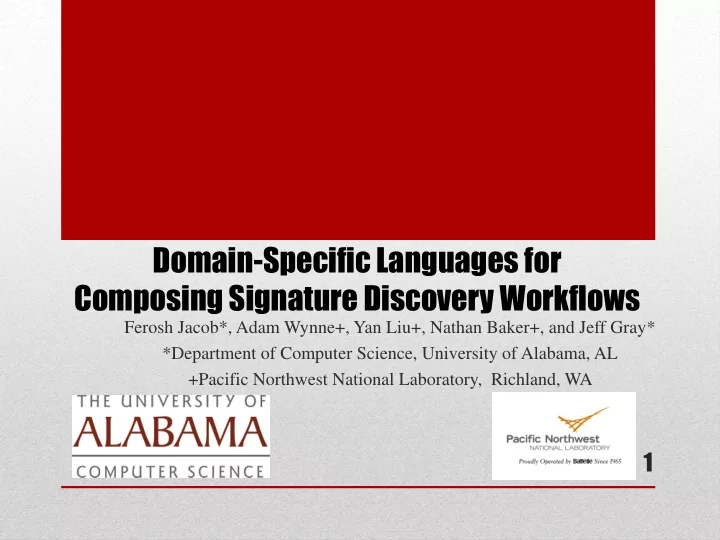

Domain-Specific Languages for Composing Signature Discovery Workflows Ferosh Jacob*, Adam Wynne+, Yan Liu+, Nathan Baker+, and Jeff Gray* *Department of Computer Science, University of Alabama, AL +Pacific Northwest National Laboratory, Richland, WA 1
The most widely understood signature is the human fingerprint Biomarkers can be used to indicate the presence of disease or identify a drug resistance A signature is a unique or distinguishing measurement, pattern or collection of data Combinations of line overloads that may lead to a cascading power failure that identifies a phenomenon (object, action or behavior) of interest Anomalous network traffic is often an indicator of a computer virus or malware Signature Discovery Initiative (SDI) 2
• Anticipate future events by detecting precursor signatures, such as combinations of line overloads that may lead to a cascading power failure • Characterize current conditions by matching observations against known signatures, such as the characterization of chemical processes via comparisons against known emission spectra • Analyze past events by examining signatures left behind, such as the identity of cyber hackers whose techniques conform to known strategies and patterns SDI high-level goals 3
Challenge: An approach that can be applied across a broad spectrum to efficiently and robustly construct candidate signatures, validate their reliability, measure their quality and overcome the challenge of detection Solution: Analytic Framework (AF) • Legacy code in a remote machine is wrapped and exposed as web services, • Web services are orchestrated to create re-usable tasks that can be retrieved and executed by users SDI Analytic Framework (AF) 4
• Accidental complexity of creating service wrappers In our system, manually wrapping a simple script that has a single input and output file requires 121 lines of Java code (in five Java classes) and 35 lines of XML code (in two files). • Lack of end-user environment support Many scientists are not familiar with service-oriented software technologies, which force them to seek the help of software developers to make Web services available in a workflow workbench. Challenges for scientists in using AF 5
We applied Domain-Specific Modeling (DSM) techniques to • Model the process of wrapping remote executables. The executables are wrapped inside AF web services using a Domain- Specific Language (DSL) called the Service Description Language (SDL). • Model the SDL-created web services The SDL-created web services can then be used to compose workflows using another DSL, called the Workflow Description Language (WDL). A domain-specific modeling approach 6
1. Submit job 2. Check status 3. Download files Output generated as Taverna workflow executable 7
Service description (SDL) for BLAST submission Workflow description (WDL) for BLAST Example application: BLAST execution 8
Script metadata (e.g., name, inputs) Execution SDL Retrieve documents (e.g., blast.sdl) (AF framework) WDL Apply templates (e.g., blast.wdl) (Template engine) Inputs Web services Workflow (Taverna engine) Web services Taverna workflow @Runtime (e.g., checkJob) (e.g., blast.t2flow) Outputs Implementation 9
• Compared to domain-independent workflows like JBPM and Taverna, our framework has the advantage that it is configured only for scientific signature discovery workflows. • Most of these tools assume that the web services are available. Our framework configures the workflow definition file that declares how to compose services wrappers created by our framework. Related works 10
We successfully designed and implemented two DSLs (SDL and WDL) for converting remote executables into scientific workflows. SDL can generate services that are deployable in a signature discovery workflow using WDL. We separated the domain-specific information required to create the workflows from the accidental complexities introduced by webservices and the Taverna workflow engine, which allows end-users (scientists) to design and develop workflows Summary 11
Questions ? 12
Submit BLAST Check the status of job in a cluster the job Download the output files upon completion of the job. Example application: BLAST execution 13
Xtext grammar for WDL 14
No Utils/Script {Inputs (type)] [Outputs(type)] LOC Total LOC (files) Service 1 echoString echo [0][1 (doc)] 10+13+1+6 30(4) 2 echoFile echo [1 (String)] [1 (doc) ] 10+14+1+6 31(4) 3 aggregate cat [1(List doc) ] [1 (doc) ] 10+20+1+7 38(4) 4 classifier_Training R [2 (doc), 1 (String) ] [1 (doc) ] 11+24+2+8 45(4) classifier_Testing R [3 (doc), 1 (String) ] [1 (doc) ] 12+29+2+8 51(4) 5 6 accuracy R [1 (doc) ] [1 (doc) ] 11+19+1+6 37(4) 7 submitBlast SLURM, sh [3 (doc) ] [2 (String) ] 17+27+2+8+18 72(5) 8 jobStatus SLURM, sh [1 (String) ] [1 (String) ] 10+14+1+6 31(4) 9 blastResult cp [1 (String) ] [1 (doc) ] 10+14+1+6 31(4) 10 mafft mafft [1 (doc) ] [1 (doc) ] 10+18+1+6 35(4) An An ove vervi view of SDL SD L co code de gene nera ratio tion 15
Taverna classification workflow 16
Recommend
More recommend